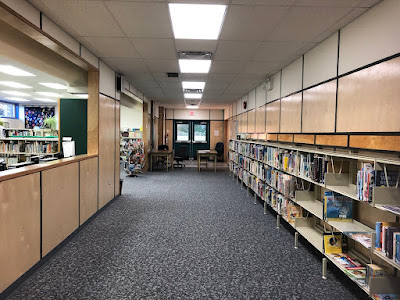LIBE 463: THEME 1 DISCUSSION: JAN 10TH TO 16TH: COMMUNITY ANALYSIS: ROBERTA'S BLOG
Community Analysis:
As I read the text, The Collection Program in Schools: Concepts and Practices (2016) and examine the 5 laws of library science:- books are for use
- every person his or her book
- every book its reader
- save the time of the reader and
- a library is a growing organism (Mardis, p. 2)
Although tidy and organized, our library could be seen as a scene from "The Twilight Zone." Much of our collection and equipment is outdated.
When I first began teaching at our school I found a book that I had signed out in 1974! You can bet I culled that book and many others!
It wondered when the last time books were culled at our school. I recognize the responsibility that goes with ensuring our library is "a responsive learning environment where students and teachers work together to find information, answer questions, and develop new knowledge (CASL, p.4).
As I have stated in previous courses, I see librarians as "Superheroes." The responsibility the school librarian has to undertake can seem insurmountable when considering "the range of barriers [that] limit access to information" (Mardis, p. 3).
Our school faces many barriers to "develop[ing] students who are information literate (CASL, p.4). Mardis describes the barriers as cultural, physical and intellectual (Mason, p. 3).
The barriers we face are:
Cultural: our current collection is dated and "lacks a wide range of genders or ethnicities among its protagonists" (Mason, p. 3).
Physical: Our school library could be redecorated to be more inclusive and accessible. We would truly benefit from updated equipment (Mason, p. 3).
Intellectual: Limited access to the outside world, due to lack of resources, time allocated for library services, knowledge of available resources etc.
Due to lack of library services and living in an isolated and rural community, our library remains only “a starting point for students as they begin to search for information” (Mardis, p. 3).
Transforming our library into a place of “accessibility” (Mardis, p. 3), will take involving the school community and adopting a collaborative approach. "All members of the school faculty share responsibility for the library program. A school librarian cannot run an effective, integrated program alone" (Mardis, p. 4).
The easiest part of the process will be identifying the dire needs towards transforming our library into a place where “the school librarian guides students to becoming critical thinkers, enthusiastic readers, skillful researchers, and ethical users of information” (Mardis, p. 3).
Our school has been allocated a librarian for 1 hour and 20 minutes per week! Meeting the new conceptions of Ranganathan’s laws (Mardis, p. 2) will involve a huge undertaking.
Steve does a lot of the purchasing, organizing and general care of the library. I currently collaborate with the teachers about skills and topics they would like their students to learn about.
Recently, I collaborated with the grade K/1/2/3 teacher to decide what skills and knowledge I had to share. In the primary class we learned about Canada's provinces and territories and in the intermediate class we learned about research and note-taking skills. I knew personally what skills the students needed to work on because I am also their part-time classroom teacher.
This term the primary class are raising salmon. I sought out lessons and resources that revolve around the teacher's class theme. I found a fabulous website for purchasing popular books that on many occasions include an accompanying lesson plan.
I chose the book, A Salmon for Simon to share with Mrs. Bragan our primary teacher. See the Strong Nations website (https://www.strongnations.com/) for a copy of the lesson plan that accompanies the book.
Some of the programs our school uses to enhance student learning include: Spark Reading https://spark.pearson.com/app which has been made available through the English Language Learning program but is limited to a certain number of students.
Other programs we use at school include the Kurzweill program which I am being told is a "dated" program. But on further research I have found that Kurzweill has updated their program to further meet student needs. It appears I need to acquire further training in a program I thought I was already familiar with.
I am excited and determined to create an atmosphere that is conducive to learning and inspires a desire to learn beyond the school walls.
References
Asselin, M., Branch, J., & Oberg, d., (Eds.). (2006). Achieving information literacy: Standards for school library programs in Canada. Ottawa ON: Canadian Libraries Association.
Mardis, Marcia A. (2016). The collection program in schools: Concepts and practices. (6th ed.). Santa Barbara, CA: Libraries Unlimited.

















Comments
Post a Comment